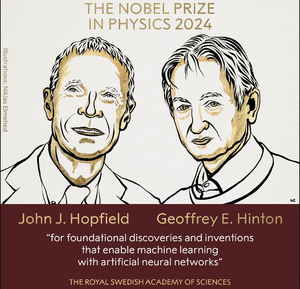America
John Hopfield and Geoffrey Hinton Awarded Nobel Prize in Physics for Breakthroughs Enabling Machine Learning

Stockholm, October 8 :
John Hopfield and Geoffrey Hinton have been bestowed the Nobel Prize in Physics for 2024 by the Royal Swedish Academy of Sciences. Their groundbreaking work has laid the groundwork for machine learning through artificial neural networks.
The two physics Nobel laureates laid the groundwork for the robust machine learning systems employed today by building on physics-based techniques. In order to discover patterns in data, the two of them turned to physics.
Many individuals have witnessed firsthand how computers can translate languages, decipher visuals, and even carry on sensible discussions, according to the Nobel Prize committee, which accompanied the study explanations.
A less well-known fact, though, is that this technology has long played a crucial role in research, particularly in the organization and examination of massive data sets. Machine learning, which makes use of a structure known as an artificial neural network, has seen tremendous growth in the last fifteen to twenty years.
The achievements of this year's physics Nobel Laureates have paved the way for machines to simulate cognitive processes like learning and remembering. They came up with technology that process data using network topologies by applying basic ideas and methodologies from physics.
In contrast, machine learning allows computers to learn from examples, which helps them deal with problems that are too complex or nebulous to be solved by hand-holding. Recognizing things in a photograph is one example of interpreting visual information.
The associative memory that Hopfield developed allows for the storage and reconstruction of images and other patterns in data.
There is a way for the Hopfield network to recreate patterns that it has stored. If the network is provided with a partially distorted or incomplete pattern, the approach can locate the stored pattern that is the closest match.
At the same time, Geoffrey Hinton came up with a way for data to independently discover attributes, which allows it to do things like recognize individual objects in images.
The architecture of the brain served as an early inspiration for the artificial neural network technology that underpins machine learning. Nodes with varying values stand in for neurons in an artificial neural network, mimicking the way the brain works.
These nodes affect one another via connections that can be strengthened or weakened, resembling synapses. One way to train the network is to make stronger connections between nodes that have high values all at once.
The Nobel Prize Committee announced in a statement that the winning researchers this year have made significant contributions to the field of artificial neural networks beginning in the 1980s.
Hopfield, who was born in Chicago in 1933, does research at Princeton University, whereas Hinton, who was born in London in 1947, is affiliated with the University of Toronto. There has been tremendous gain from the laureates' efforts thus far. New materials with precise properties are just one example of the many applications of artificial neural networks in physics, according to Nobel Committee Chair Ellen Moons.





































